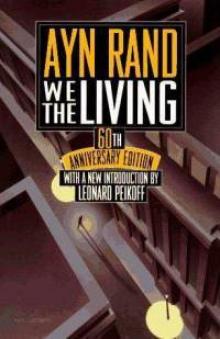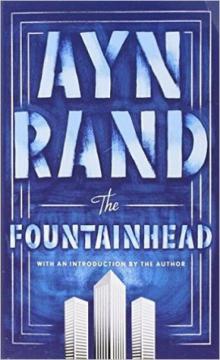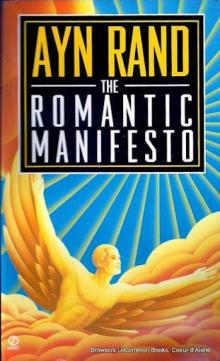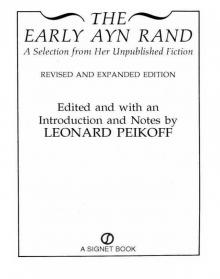The Journals of Ayn Rand Read online
Page 22
The small individual house, built in accordance with the wishes of an individual man or woman, is possibly still more indicative of the general standard of the delirium of individualism.... The construction of a dwelling-house not only shows that a feeling of ownership is a menace to this quality, but even, so it would appear, is in a degree opposed to it. For where the owner-builder is the more disposed to waive his possessive rights in favor of something really good and useful, there will not only disappear the sentimental, romantic delirium, but the houses will come to bear a certain resemblance and suitability, the one to the other.
(What logic!)
Should it not be impossible still to speak of taste, after the Stuttgart exhibition of 1927, for instance, proved that sixteen architects (all of whom differed greatly one from the other, even apart from the fact that they came from five different countries), without concerning themselves about any of the houses not actually of their own design, were yet able to evolve a suburb of a highly uniform character? A suburb in which each of them experimented in the most varied directions, proving that it was their common mental attitude which produced the unity of effect, thus excluding the question of taste. And yet, in view of the illustrations in this volume, many will assuredly contend: “That may be all very well thought out, but it does not happen to be my taste.” To which one can only reply: “Questions of taste are social questions.”
(Note: the Stuttgart exhibition is nothing but a collection of trashy, shoe-box houses, none of which means anything, consequently all of which can be considered to produce an effect of unity, the unity of nothingness.)
The coming world is most clearly expressed in its architecture, no matter from what angle it is regarded. Painting and the plastic arts keep within the calm of the studio, entangled in their problems regarding artistic form. The heroic attempts of a Picasso to set up a general consistent formula on constructive foundations are greatly to be appreciated so far as the standard of painting is concerned; yet his vacillations from Cubism to Classicism, and again from Cubism to Abstractism, must surely be indicative of a certain want of clarity as to how painting was to be linked on to the social whole. [...]
This, then, is Toohey in the flesh speaking. Little can be added to the gentleman’s own words, except to note that he has quite a bit of praise for the awful monstrosities of cast-iron columns used when iron first came into use in architecture. He praises Renaissance architecture, when necessary. He has no conception of what Wright’s fight for modern architecture means, nor its spirit, nor its purpose. All he has grasped is the “down with ornament” idea. Which is, of course, nothing but glorifying mediocrity, making architectural creation of such nature that it is open to anyone; anyone can build this senseless, awkward, common junk; genius or intelligence or taste are no longer necessary; taste particularly is deliberately denied and mocked. Note the remarks about Picasso—an attempt to connect idiotic modem painting to “the social whole,” to set up standards that deny ability, and open art to anyone and everyone. There’s Toohey’s little system.
January 10, 1938
A. T. North, Raymond Hood.
[Hood has little] to say about general principles of architecture. The book [focuses mainly on] explanations of details of his buildings, plus some second-hand statements on form following function, old re-hash of what has been said a million times before, without adding a single new thought. The illustrations of his buildings show a magnificent absence of individuality. There is no such thing as a spirit or style of his own. Anything goes. The buildings could have been done by twelve different men. Appalling lack of imagination. Plenty of Renaissance and Gothic. Modernism à la Germany. When he tries to depart from precedent in decoration and to create patterns of his own, they are horribly Renaissance, awkward and meaningless. A great deal of stealing from Wright and from E. J. Kahn. This is the man claimed by many to be the great American architect.
A glance at his list of “societies” explains it all. Note also that he has worked always with someone else, hardly ever on his own, and if he did work on his own, he produced nothing of importance in those times. He has changed a great many partners. Evidently he didn’t care with whom he worked, or so it appears from the numerous list of collaborators. Whether he was in each case the original designer or not does not matter. I do not trust people with instincts for collaboration.
January 12, 1938
A. T. North, Ralph Adams Cram.
A lovely compliment to Cram & Co. from Mr. North:In this (their use of Gothic) they have exerted a steadying influence on American ecclesiastical architecture by retaining always its essential Christian character and spirit. At the same time, they have drawn on other sources with equal success. In their design of collegiate buildings they have drawn on many architectural sources [...] with the same facility and discrimination. In all of their work they have applied a serious and scholarly effort that produces an architecture which is appropriate to its purpose and in harmony with the best human attributes.
Observe the art of sounding profound and meaning nothing whatever, such as in the last sentence.
January 17, 1938
Architectural League of New York, 1930:
All the eclecticism in the world. Modern structures, such as the Empire State Building, and some of the oldest junk. The firm of Voorhees, Gmelin and Walker has, in the same issue, a modernistic building (Roerich Museum) and a bank building in New Jersey with Greek pilasters at the entrance. Anything goes with these architects. There is a home by Delano & Aldrich (society boys) which is rather simplified à la modernistic, but with a dome in the center and a Greek portico for an entrance. There is a Sewage Disposal Plant with Greek moldings.
It is almost pathetic to see the way in which the architects feel forced to simplify their facades, yet hang on to the Greek trimmings, porticoes, orders and such—in a slightly simplified form. (As if these were the only forms of which they felt sure and they cling to them desperately, seeing nothing beyond them.)
The above applies only to commercial buildings. In the field of domestic architecture it is still the dark ages. Not one modern building. Not even a touch of modernity on the old monstrosities. The only modern [design] shown is a model home built or projected by House & Garden.
February 15, 1938
N. C. Curtis, Architectural Composition.
A silly book, musty, naive and old-fashioned, smelling of the XIX century, even though it is published in 1935. Written by a professor of architecture. Gives a marvelously clear picture of what the academic mind thinks of architecture and of what it teaches to students. [...]
A lot of drivel on the idea of making a plan attractive in itself, not in what it represents, but in itself, as a picture. This seems hard to believe, even for the old days. (Check up on this.)
Advice to students in learning to make beautiful plans: “Progress will only come through practice; by the study of beautiful plans, chiefly through tracing them.”
Throughout the book, a continuous emphasis on the “monumental,” which seems to be the one type of architecture the author is most interested in—and the one most useless. Traditional architecture, the great body of the master works of past epochs of architecture, is the store house from which we ought to draw and in most cases to draw all the inspiration that goes to make for the greatness of our contemporary designs. The greatest commentators are no uncertain advocates of this doctrine. Let us hear what M. Gaudet has to say:
“I know that to speak of tradition now passes far behind the times; the present tendency is to scorn tradition. That means to despise long efforts continued through centuries by the industrious generations preceding us; to seek generally to conceal ignorance by affecting to scorn the unknown in order to avoid the effort necessary to know it. Preserve yourselves from this error! Progress is slow and must be sure. Whoever proceeds slowly is sane, and whoever is sane goes far. Do you know what is very strong and original? It is to do very well what others have merely done well. The finest epochs are those in which tradition was most respected, when progress was continually perfecting, when there was evolution and not revolution. Never has there been spontaneous generation in art. Between the Parthenon and the temples preceding it are only shades of difference. Furthermore and especially for studies is tradition precious. To dare to become free from it one must judge it, and to do this it must be known. Tradition is a paternal patrimony; to dissipate it independently, one risks finding himself wandering at random and must at least know how to find himself another shelter.”
This sounds like the despair of a bunch of quacks or witch doctors, who have held power for a long time by reason of their specialized knowledge in a field made mysterious, cluttered with minute details and requiring years of study, such dull and useless study of so much that is inessential, that few would enter it and the witch-doctors, consequently, held sway and ruled all architecture. When the people are leaving them, at last, they rack their brains for some excuse to hold on to their phony position of prestige: we gotta have tradition, and if not, we gotta study it anyway, at least in order to discard it, etc. But please study it, because this is our field, our second-hand claim to prestige and distinction! [...]
This is a magnificent sample of what every thinking person in any line is up against.
Simple and regular type forms of buildings, often of colossal dimensions, have been employed in all ages to embody purely idealistic concepts, or other ideals removed from the merely useful or material. Such are the temples, mausoleums and monuments of antiquity and the great cathedrals and churches of Christian epochs.
Here is an important point of difference. Howard Roark will make all buildings “idealistic,” for every phase of life. Real life on earth, not in heaven, can and must be made beautif
ul.
Research and careful study of the masterworks of architectural art are most essential factors in training. By strengthening taste, discrimination is thereby made more sure and the novice will have the right to feel that he has climbed many steps when he is able to select the good from the inferior. It is well to remember that in the study of design it is far better to copy something that is really good than to try to create out of a limited imagination. After all imagination is rather largely a matter of memory, if it is not all that. In architecture, it has been said, the sort of originality that consists in the use of old materials is quite satisfactory for all purposes. It was good enough for the Greeks, why not for us?
(Sic!)
In conclusion:I am only paraphrasing the words of Sir Joshua Reynolds, when he said: “The habit of contemplating and brooding over the ideas of great geniuses, until you find yourself warmed by the contact, is the sure method of an artist-like mind.”
Isn’t there something here to explain why geniuses are so often recognized only after they’re dead? When they are alive, they’re a menace to the second-handers. But when they are dead, their glory can be appropriated safely by these second-handers who then accept the prestige of specialists in that which their own kind would never have acknowledged while the author was there to claim his own glory. (Also: how many of these recognized geniuses are such and how many the creation of the second-handers?)
Frank Lloyd Wright, The Disappearing City.
No notes. More of Wright’s ideas. Some beautiful, a great many not clear. More about sociology than about architecture. [He speaks of] architecture as a force shaping society. (Which it isn’t.)
August 15, 1938
From a speech by Charles D. Maginnis, president of the A.I.A., at the Institute’s convention in New Orleans, April, 1938 [published in the May issue of The Architect’s World]: It is to be remarked that the world of our youth, to the understanding of which our minds were so very painfully adjusted, is in the act of tumbling about our heads and we are largely engaged in testing the validity of the fragments in the expectation of constructing a better one. Inevitably the process is attended by violent conflict of opinion. In the political order, for instance, we had been deeply grounded in the faith that, with all its familiar inefficiencies, the democratic type of society offered the highest exercise and the most lasting satisfaction for the human spirit. We now confront a mounting philosophy based upon its complete denial. More profoundly still we had believed in the cogency of the Divine principle in civilization. A strange new world rejects it as an anemic and disturbing anachronism....
This is terribly important. Here is a man who fights modern architecture and individuality, as later quotes show, an eclectic and a second-hander par excellence. And he is precisely the type that would state and accept as a fact that “the world is tumbling about our heads.” Who told him it was tumbling? What grounds has he to believe so? Only the Red propaganda, which he has accepted promptly and readily because he thinks that that is the way the wind is blowing. He has never had any standards and is, therefore, willing to abandon what he thought to be standards, willing to abandon anything. He is willing to gather the fragments and “build a better world.” Better—with the denial of democratic rights included? This is to be stressed. It is men like Peter Keating who make men like Toohey possible; by denying standards, they are ready to accept any standards handed to them by anyone, or forced upon them. Keating will submit to Toohey as he submitted to everyone and everything else. Toohey is the type who knows how to reap the harvest of the second-handers.
After grudging, half-hearted, bromidic, meaningless compliments to modern architecture, the speaker shows what is really in his heart:And so, in this attitude of reserve, we may welcome the stimulation of the new movement with all the challenge of its bitter rationality. That there is refreshment in it we have already noted in the clarity, vitality and independence it has brought to all design, even as we remark that, unlike Europe, we have not as yet yielded to its complete implication. Whether it hold the gift of completely alienating the past still remains to be proven. We have not yet seen the convincing evidence and it is always to be remembered that an artistic philosophy must propitiate the eye no less than the reason. This may take a little time. The human spirit has a way of finding its own satisfactions, and logic does not figure too largely in the matter.
(Note the second-hander’s invariable disparagement of logic in favor of “spirit” or “sentiment.”)
It may well be that the modem thesis is over-bold. It comes to one, for instance, that of the new materials with which its philosophy is identified, it is perhaps the single weakness of steel that, with all its thrilling capacities, it cannot make for interesting ruins. It is a point not to be overlooked, for even ruins have their eloquent and venerable importance. Always it has been architecture which has given us testimony of the ages. Someone has said: “show me the buildings of a people, and I will tell you its history.” If we are content to render our own civilization in an architecture dependent upon steel, a reasonably remote posterity can have no visual knowledge of us, which might be a pity. In this there may be hint that the historic principle of structure is not quite discredited and that walls will still be built against which our posterity may bark its shins. For it is worthy of remark that it is the walls and not the space which have so intelligently survived. Perhaps it may not be too hazardous a prediction that the great and significant buildings of the generations will be built in the future, as they have been always built, in terms of articulated and enduring masonry.
(This speaks for itself! The most priceless bit I have yet found.)
6
PLOT
After two years of working on The Fountainhead, AR was clear on the theme and characters, and had learned a great deal about architecture. But she had not yet worked out certain key elements of the plot. In particular, she did not yet have the idea for the climax of the story, i.e., Roark’s dynamiting of Cortlandt Homes and the subsequent trial. Long after the publication of The Fountainhead, she recalled her difficulties: I had the most impossibly difficult time, and nothing in the story could be set firmly, only tentatively, until I had the climax. And that was a real mind-breaker. I needed an event which was connected with architecture, but which would put Roark in the position of real danger and of antagonizing the whole of society. And, incidentally, I found that dramatizing events of an architect’s career is enormously difficult, because the art itself is physical, it doesn’t deal with people. All the conflicts have to be ideologically tied to the building, but they are not about the building as such. A lawyer or a doctor would be much easier to dramatize. And I remember cursing the profession for that reason....
It was while working in the office of E. J. Kahn that Ayn Rand thought of her dramatic climax. Kahn mentioned to her one morning that the biggest technical problem in architecture was the design of low-rent housing projects. That day, while eating lunch in a nearby cafe, she arrived at the idea of Roark designing and dynamiting Cortlandt Homes. She had solved the most difficult problem in planning the book—she finally had the essential element of the plot. The following notes begin in March of 1938, shortly after this breakthrough, at about the time that she quit her job with Kahn.
Approximately two-thirds of her notes from this last pre-writing period are presented here. I have omitted outlines that are repetitive or that merely describe events as they happen in the published novel.
March 8, 1938

 Anthem
Anthem We the Living
We the Living Atlas Shrugged
Atlas Shrugged The Fountainhead
The Fountainhead The Romantic Manifesto: A Philosophy of Literature
The Romantic Manifesto: A Philosophy of Literature The Classic Sci-Fi Collection
The Classic Sci-Fi Collection The Early Ayn Rand
The Early Ayn Rand